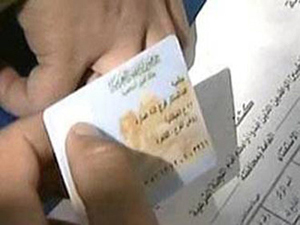 With the upcoming parliamentary elections approaching, and coverage of all that pertains to it occupying a sizeable portion of media coverage, I thought of checking my voting card in preparation. Not surprisingly, years of use had left their mark on the paper, hand written card. Let me remind the reader that in Egypt voting cards are issued in paper form and are hand written, which makes them difficult to read owing to normal handwriting flaws and because of the predictable erosion with the passage of time.
With the upcoming parliamentary elections approaching, and coverage of all that pertains to it occupying a sizeable portion of media coverage, I thought of checking my voting card in preparation. Not surprisingly, years of use had left their mark on the paper, hand written card. Let me remind the reader that in Egypt voting cards are issued in paper form and are hand written, which makes them difficult to read owing to normal handwriting flaws and because of the predictable erosion with the passage of time.
Voting cards lose their grip
Opinion
00:09
Sunday ,19 September 2010

Despite the weight it carries as an official document—it denotes the balloting identity of an Egyptian—the pink-coloured, soft cardboard voting card is extremely outdated in appearance and content. It stands no chance before today’s plastic or smart cards, including the national ID, driving and car license cards, club membership cards, credit cards, health or even mobile phones charging cards.
The emblem of the Arab Republic of Egypt tops the card, followed by the title “The Interior Ministry”, then the card definition “Voting certificate according to the law of exercising political rights”. The card is then jammed with data; beginning with the personal details of the card-holder, to a list of the dates of the polls in which he or she cast their ballots. It is a challenge to read or identify all the data hand written on the card. Some cards, mine included, record several changes regarding the balloting centres in which the card is registered or the registration number on the electoral 1ists. And despite the plethora of information the card carries, I invariably have to roam through a number of balloting centres every election until I discover which one has my name on its lists.
The many problems relating to voting cards and voter lists, which arise with every election, cast doubts upon the validity of the voting card as an official voting document. The Interior Ministry has repeatedly declared that voter lists go through revision and updating to eliminate the names of those who died or for some reason or another lost their political rights, and to add the names of new voters. Yet the problems persist, with not a few voters complaining of spelling errors, non-notified change in registration numbers or balloting centres, or that their names go entirely missing from the lists.
Such flaws in the voting card system were considered unfortunate, even if regrettably possible, as long as the computerised national ID card had not seen light. But it is seven years now that the information relating to every Egyptian was being placed on a computerised data base, making it merely a matter of rudimentary conventional wisdom to replace the outdated voting cards with the modern ID cards.
When the first batch of computerised ID cards was issued, officials declared that the new card would include all the data relating to its holder. It should put an end to all redundancy or conflicting data, and to any attempted forgery or falsification, they claimed. The new cards would be the sole ID verification, and would constitute the only basis for dealings between the citizen and the State, banks or various bodies that demand proof of identity.
So why is the Interior Ministry taking its time to replace the voting cards with the ID cards? Why does it wear itself thin trying to resolve the problems with voting cards? Why does it not rid itself of the headache of linking the electoral lists to the voting cards instead of the ID cards? These questions and many more await answers, especially that the upcoming parliamentary elections will be followed by the more critical presidential elections in 2011.
Until then, not few of us will still complain of not finding our names on the electoral lists or of the non-conformity of the names on the voting cards and those on the lists. And we will still read news of deceased persons who allegedly cast ballots and of those who are alive but could not.


